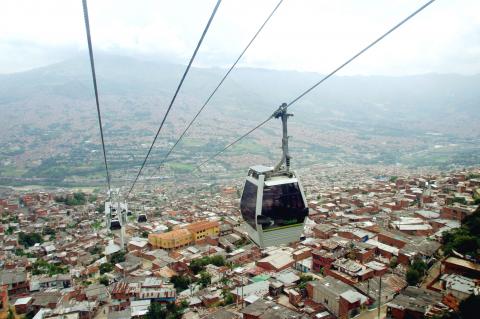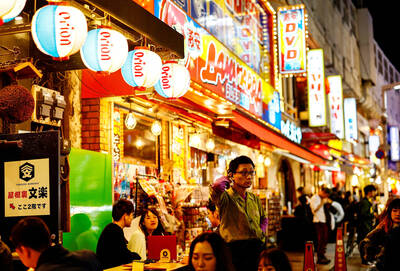For some time now, if you asked architects and urban planners for proof of the power of public architecture and public space to remake the fortunes of a city, they’d point here.
Twenty-odd years ago, this was Pablo Escobar’s town, with an annual homicide rate that peaked at 381 per 100,000. In New York City that would add up to an almost inconceivable 32,000 murders a year.
But Colombia’s second city has lately become a medical and business center with a population of 3.5 million and a budding tourist industry, its civic pride buoyed by the new public buildings and squares, and exemplified by an efficient and improbably immaculate metro and cable car system. Linking rich with poor neighborhoods, spurring private development, the metro, notwithstanding shrieks elsewhere in Colombia over its questionable construction cost, is for residents of Medellin a shared symbol of democratic renewal. Even on the rush-hour train I took the other morning, crowds stepped aside to let a cleaning woman with a mop and bucket scrub the floor.

Photo: Bloomberg
That evening I headed high up into a steep hillside slum where rival gangs still shoot unsuspecting trespassers who cross invisible borders. The city has recently installed an escalator ascending 396m, much debated at US$7 million and disconnected from the rest of the city’s transit network but shortening to a five-minute ride what had been a brutal 30-story climb for some 12,000 residents. I trudged by foot, past armed soldiers, past mothers taking breathers on the decrepit steps that meandered up the mountain, past toddlers on plastic tricycles plunging down vertical streets, to a brightly painted cinderblock hut, a ramshackle aerie overlooking a sprawl of tin houses and open sewers.
The shack is home to Son Bata, a cultural initiative founded by young black migrants from the Choco region of Colombia. Son Bata promotes Chocano music and dance, and it benefits from yet another Medellin initiative: participatory budgeting. Residents here have voted to direct a share of government financing to new schools, clinics and college scholarships. Son Bata got to hire music teachers and bought instruments and is adding a new recording studio to its headquarters. A group of players showed me the studio under construction. From another room, music drifted over the barrio and into the warm night air.
I arrived in Medellin to see the ambitious and photogenic buildings that have gone up, but also to find what remains undone. The murder rate, while hardly low, is now under 60 per 100,000.
Architecture alone obviously doesn’t account for the drop in homicides, but the two aren’t unrelated, either.
Around the world, followers of architecture with a capital A have focused so much of their attention on formal experiments, as if aesthetics and social activism, twin Modernist concerns, were mutually exclusive. But Medellin is proof that they’re not, and shouldn’t be. Architecture, here and elsewhere, acts as part of a larger social and economic ecology, or else it elects to be a luxury, meaningless except to itself.
The story of Medellin’s evolution turns out to be neither as rosy nor as straightforward as fans of new architecture have tended to portray it. It’s generally told as a triumph for Sergio Fajardo, the son of an architect who is the governor of the region and who was the city’s visionary mayor from 2004 to 2007. He pushed an agenda that linked education and community development with infrastructure and glamorous architecture.
But the city’s transformation established roots before Fajardo took office, in thoughtful planning guidelines, amnesties and antiterrorism programs, community-based initiatives by Germany and the UN and a Colombian national policy mandating architectural interventions as a means to attack poverty and crime.
What sets Medellin apart is the particular strength of its culture of urbanism, which acts now almost like a civic calling card. The city’s new mayor, Anibal Gaviria, spent an hour describing to me his dreams for burying a congested highway that runs through the middle of town, building an electric tram along the hillsides to stem the sprawl of the slums, adding a green belt of public buildings along the tram, rehabilitating the Medellin River and densifying the city center — smart, public-spirited, improvements.
It’s as if, in this country whose relatively robust economy has underwritten many forward-thinking projects, every mayor here has to have enormous architectural and infrastructural plans, or risk coming across as small-minded or an outsider.
THE BIGGER PICTURE
Gaviria, local designers, businessmen and community leaders sketched for me a picture of a city in which violence, much of it today by small drug traffickers, remains a big problem and victories are fragile. People in Medellin were cautious about the future, about easy solutions and seeing architecture as an end in itself. At the same time, they stressed the social and economic benefits that public architecture and new public spaces can create, and the wisdom of long-term, community-based policies of urban renewal.
“A holistic approach,” is how Alejandro Echeverri, one of the principal architects of the city’s transformation under Fajardo, described the philosophy.
I came here from Bogota, whose renewal programs starting in the late 1990s — like earlier ones in Barcelona before the Olympics in 1992 — set the stage for Medellin’s revival. But now Bogota is suffering, as strains multiply on its famed rapid bus system and residents’ faith in the city’s future plummets.
Medellin, by contrast, still counts on an almost fierce parochial pride, a legacy of decent Modernist architecture dating back to the 1930s, a cadre of young architects being aggressively nurtured and promoted, and a commitment by local businesses to improve social welfare that begins with the city’s biggest business: its state-owned utilities company, EPM.
You can’t begin to grasp Medellin’s architectural renaissance without understanding the role of EPM, the Empresas Publicas de Medellin, which supplies water, gas, sanitation, telecommunications and electricity. It’s constitutionally mandated to provide clean water and electricity even to houses in the city’s illegal slums, so that unlike in Bogota, where the worst barrios lack basic amenities, in Medellin there’s a safety net.
More than that, EPM’s profits (some US$450 million a year) go directly to building new schools, public plazas, the metro and parks. One of the most beautiful public squares in the middle of Medellin was donated by EPM. And atop the slums of the city’s Northeast district, EPM paid for a park in the mountaintop jungle, linked to the district by its own cable car.
Federico Restrepo used to run EPM, before he became the city planner under Fajardo. “We took a view that everything is interconnected — education, culture, libraries, safety, public spaces,” he told me, pointing out that while fewer than 20 percent of public school students here used to test at the national average in 2002, by 2009 the number exceeded 80 percent.
“Obviously it’s not just that we built and renovated schools,” he said. “You have to work on the quality of teaching and nutrition in conjunction with architecture. But the larger point is that the goal of government should be providing rich and poor with the same quality education, transportation and public architecture. In that way you increase the sense of ownership.”
But of course ownership can’t just be bestowed on poor neighborhoods; it must also be declared, in small, critical ways.
In the troubled Comuna 13, two members of Revolucion Sin Muertos (Revolution Without Deaths) — started not long ago by a group of neighborhood hip-hoppers rejecting the gang culture — took me on a graffiti tour. At a crowded street corner, Daniel Felipe Quiceno, known as Dog, and Luis Fernando Alvarez, who is called AKA, pointed to a mural of four of their own, murdered by local gangs.
Revolucion Sin Muertos paints murals around Comuna 13; sometimes residents put their own tags on them, as if to signal support. Murals, Alvarez said, have helped people here vent frustration and proclaim ownership of the neighborhood.
Progress is hard. Venture a few meters from the heralded new squares, library and cable car stations in the Santo Domingo barrio, across town in the hills of the Northeast district, and it’s clear just how dramatic but also tenuous change is here. Echeverri met me at the cable car terminal one morning for the ride into the Northeast slums.
“We were already working before Fajardo on how to use cable cars to transform the surrounding area, to have the cable car stations as the neighborhood nervous system,” he recalled. “The barrios always had lots of energy but the energy was disconnected from the city.”
Our car rose high above a sea of illegal houses, the cable car stations creating a spine of commercial development up the mountainside. In what used to be a district too risky even for the police to patrol, we got off and wandered through a souk of restaurants, schools and clothing stores, leading onto busy squares and then to the Espana library, the most conspicuous emblem of the new Medellin.
“A seed to plant trust,” is how Echeverri described the neighborhood after its makeover. “The main physical transformation is to public space, but it’s only the beginning,” he cautioned, gesturing toward the sprawl of poverty just beyond the new development.
Echeverri said all the headlines about the recovery of this much-photographed barrio have been great, but they’ve also had the unintended effect of inclining some officials to look elsewhere, for less politically complex projects.
He showed me the US$4 million Espana library: three linked black boulders perched 1,5427m over the valley, designed by the gifted Bogotan architect Giancarlo Mazzanti, which has become a community center and civic symbol. It’s impressive from the outside.
But there are serious problems on the inside. The buildings are steel-frame boxes clad in dark stone tiles, with floating concrete cores — in effect, boxes within the boxes with reading rooms, a child-care center, an auditorium and other facilities. Construction is shoddy, navigation confusing, the interior claustrophobic; acoustics are awful, windows scarce.
EVERY LITTLE BIT COUNTS
More impressive but less flashy is another library in Medellin by Mazzanti: the Leon de Greiff library in La Ladera also a trio of buildings, in this case well-connected cantilevered pods on slate pedestals, splayed like a fan across the brow of a hill. The shared roof is linked to a park next door. Views are spectacular. The reading rooms and children’s play areas look out through panoramic windows.
Echeverri took me down the hillside to Andalucia, another part of the Northeast slums. Formerly ruled by gangs who held opposite sides of a garbage-clotted creek, it’s now remade with a sports complex and school, new sidewalks, new mid-rise housing blocks and a bridge over the creek. Dozens of shops have opened. Men were tinkering beneath cars in the hot sun, chatting over beers, when I visited; children dawdled on the way home from school, eating ice cream on the bridge. A thousand eyes were on the streets.
There I found Mateo Gomez, a 20-year-old on his way to work at a local beer company in the city center. The cable car had cut his commute in half, from two hours to one, he told me.
“The Espana library changed our conception of ourselves,” he added. “Before, we felt a stigma. But we’re still missing cultural spaces, the library closes too early, the situation is still very uncertain.”
From the hills of the Northeast, I made the circuit of some of the other new architecture in Medellin, much of it in and around the Botanical Garden, which had been the city’s Central Park before it became too dangerous to visit, and was shut down. For a while, the garden was intended for demolition. Then, a decade or so ago, thanks to Pilar Velilla, the garden’s director at the time, and with the support of Fajardo, the area was turned around.
Echeverri has designed a dramatic new science museum and public plaza across the street from the garden, and the garden has been lovingly renovated, its walls taken down, a gem of a circular pavilion, by Lorenzo Castro and Ana Elvira Velez, added at the entrance.
After an initial scheme to hire Norman Foster to devise another pavilion was rejected, a local competition was held, with the idea of advertising Medellin’s own young architectural talent. The winner, JPRCR Architects (Camilo Restrepo runs it), and Plan B Architects (Felipe Mesa and Alejandro Bernal), came up with the Orquideorama, a towering wood meshwork canopy rising 65 feet above a latticed patio. Its 10 hexagonal flower-tree structures, collecting fresh rainwater and woven together like honeycombs, shelter an orchid collection and butterfly reserves. The canopy is at once formally economical and spectacular.
But the most remarkable building of all is a few blocks away, a cultural center in the neighborhood called Moravia, next to a vast garbage dump. The center is one of the last works by the Colombian master Rogelio Salmona, a quasi-Moorish design of refined simplicity, all transparency, modesty and openness.
Carlos Uribe, an artist, who runs the center, showed off the beehive of below-ground practice rooms, the dance studio and theater opening onto the outdoors, the library and courtyard, flanked by low ramps, providing a desperately needed safe and attractive public space, where small children romped before watchful teachers among burbling fountains that recalled the Alhambra.
The authorities have lately been moving residents from the unsafe landfill next door to new housing on the city’s periphery, which is understandable but a striking case of thoughtless urban planning, because the move isolates the residents from their jobs and what had become their neighborhood, with Salmona’s building as its anchor.
“Of course we will continue to improve schools and neighborhoods,” Gaviria, the mayor, had told me. “But we also need to care for the mountains and the river, which to us are like the rivers and Central Park in New York.”
My impression from that conversation was that it’s politically easier to propose new plans for burying highways and building trams in the hills than to untangle old problems, and that the city still had to be vigilant when it comes to housing policies.
I met just before I left with eight young architects at the Museum of Modern Art, a steel mill from the 1930s, handsomely converted. “We’re still not thoughtful in terms of social housing, mixed neighborhoods,” agreed Veronica Ortiz Murcia, a partner at Arquitectura y Espacio Urbano.
“There’s a general feeling among young architects of a missed opportunity here,” said another architect, Catalina Ortiz. That view was echoed by Camilo Restrepo and Alejandro Gonzalez.
Their skepticism seemed almost the most encouraging sign I had encountered in Medellin. The city has made big strides, after all, using cutting-edge architecture as a catalyst. But here young architects press for yet more creative solutions. They take for granted as their jobs both formal innovation and also the humanitarian role of architectural activism, leapfrogging an older generation of architects and others who have remained fixated on eye-catching buildings to grace the covers of glossy magazines.
It’s this restless energy among an up-and-coming generation, in a city where people already take seriously the goal of greater equality, that seems to promise change will continue.

May 11 to May 18 The original Taichung Railway Station was long thought to have been completely razed. Opening on May 15, 1905, the one-story wooden structure soon outgrew its purpose and was replaced in 1917 by a grandiose, Western-style station. During construction on the third-generation station in 2017, workers discovered the service pit for the original station’s locomotive depot. A year later, a small wooden building on site was determined by historians to be the first stationmaster’s office, built around 1908. With these findings, the Taichung Railway Station Cultural Park now boasts that it has

The latest Formosa poll released at the end of last month shows confidence in President William Lai (賴清德) plunged 8.1 percent, while satisfaction with the Lai administration fared worse with a drop of 8.5 percent. Those lacking confidence in Lai jumped by 6 percent and dissatisfaction in his administration spiked up 6.7 percent. Confidence in Lai is still strong at 48.6 percent, compared to 43 percent lacking confidence — but this is his worst result overall since he took office. For the first time, dissatisfaction with his administration surpassed satisfaction, 47.3 to 47.1 percent. Though statistically a tie, for most

Six weeks before I embarked on a research mission in Kyoto, I was sitting alone at a bar counter in Melbourne. Next to me, a woman was bragging loudly to a friend: She, too, was heading to Kyoto, I quickly discerned. Except her trip was in four months. And she’d just pulled an all-nighter booking restaurant reservations. As I snooped on the conversation, I broke out in a sweat, panicking because I’d yet to secure a single table. Then I remembered: Eating well in Japan is absolutely not something to lose sleep over. It’s true that the best-known institutions book up faster

In February of this year the Taipei Times reported on the visit of Lienchiang County Commissioner Wang Chung-ming (王忠銘) of the Chinese Nationalist Party (KMT) and a delegation to a lantern festival in Fuzhou’s Mawei District in Fujian Province. “Today, Mawei and Matsu jointly marked the lantern festival,” Wang was quoted as saying, adding that both sides “being of one people,” is a cause for joy. Wang was passing around a common claim of officials of the People’s Republic of China (PRC) and the PRC’s allies and supporters in Taiwan — KMT and the Taiwan People’s Party — and elsewhere: Taiwan and